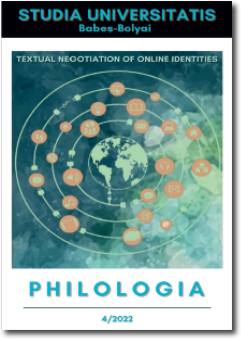THE CATCHINESS OF CODE-SWITCHING: PLURILINGUALISM IN “CATCHY” (A ROMANIAN WOMEN’S E-ZINE)
DOI:
https://doi.org/10.24193/subbphilo.2022.4.09Keywords:
code-switching, (women’s) e-zine, discourse analysisAbstract
The Catchiness of Code-Switching: Plurilingualism in Catchy (A Romanian Women’s E-Zine). This case study investigates code-switching as a salient feature of women’s online magazines. The corpus is made up of textual material posted on catchy.ro, self-proclaimed “the only premium-luxury-e-zine in Romania which privileges editorial content”. In the first instance, Daniela Hăisan will look into the plurilingualism which characterises the structure and site map of the online magazine, and then into the plurilingualism which singularises the (feature) articles as narratives about identity, filtered through subjective experiences of everyday life. Four major criteria are taken into account when analysing the corpus: visual embeddedness, preferred embedded language(s), types of code-switching (tag-switching, inter-sentential switching, and intra-sentential switching), and morphology of the embedded language. The main conclusions are that code-switching is used in order to make a statement about the writer’s identity while fostering a rapport with the target group of readers, and that it is less a sign of language decline as it is of a gradual movement towards informality.
Article history: Received 3 August 2022; Revised 16 October 2022; Accepted 28 October 2022; Available online 20 December 2022; Available print 30 December 2022.
REZUMAT. Caracterul proliferant al schimbării de cod: Plurilingvismul din Catchy (o revistă românească online pentru femei). Prezentul studiu de caz investighează schimbarea de cod ca trăsătură distinctivă a revistelor online pentru femei. Corpusul este alcătuit din texte postate pe catchy.ro, autoproclamată “singura revistă online românească premium-luxury în care conținutul editorial este primul cel prețuit”. Într-o primă instanţă, vom analiza plurilingvismul care caracterizează structura şi harta site-ului revistei, apoi plurilingvismul care particularizează articolele şi editorialele ca naraţiuni despre identitate, filtrate prin experienţele subiective ale vieţii de zi cu zi. Patru criterii majore sunt luate în considerare în analiza corpusului: integrarea grafică a elementelor din limba engleză, limba/limbile secundare preferate, tipuri de schimbare de cod (tipul tag, intra- şi inter-propoziţionale) şi aspecte morfologice ale limbii secundare. Principalele concluzii privesc folosirea schimbării de cod ca declaraţie şi afirmare a identităţii scriitorului online dar şi ca modalitate de a stabili o relaţie de afinitate cu grupul-ţintă de cititori; schimbarea de cod este interpretată nu atât ca simptom al deteriorării limbii, cât mai ales al unei deplasări treptate către registrul informal.
Cuvinte-cheie: schimbare de cod, revistă online (pentru femei), analiza discursului
References
Ballaster, Ros, Margaret Beetham, Elizabeth Frazer, and Sandra Hebron. 1996. “A Critical Analysis of Women’s Magazines.” In Turning it on: A Reader in Women and the Media, edited by Helen Baehr and Ann Gray, 87–96. London: Edward Arnold.
Bancu, Ariana. 2013. “A Comparative Analysis of Romanian-English and Romanian-Spanish Code-Switching Patterns.” Studies in the Linguistic Sciences: Illinois Working Papers 38: 172–183.
Bancu, Ariana. 2014. “Language Selection in Code-Switching: An Analysis of Nouns from Romanian-English Code-Switching.” Texas Linguistics Forum 57: 13–24.
Grutman, Rainier. 2001. "Multilingualism and Translation.” In Routledge Encyclopedia of Translation Studies, edited by Mona Baker and Kirsten Malmkjær, 157–160. London/New York: Routledge.
Baron, Naomi S. 2008. Always On. Language in an Online and Mobile World. Oxford: Oxford University Press.
Bullock, Barbara, and Ameida Jaqueline Toribio (eds.). 2009. The Cambridge Handbook of Linguistic Code-Switching. Cambridge: Cambridge University Press.
Butler, Judith. 1988. “Performative Acts and Gender Constitution: An Essay in Phenomenology and Feminist Theory.” Theatre Journal 40(4): 519–531.
Cameron, Deborah. 1995. Verbal Hygiene. The Politics of Language. London/New York: Routledge.
Cocu, Iulia Veronica. 2016. “The Language of Social Networks – The Lingua Franca of Tomorrow.” Analele Universităţii “Dunărea de Jos” din Galaţi, tome XXIV, year IX, 1–2 (15–16), Proceedings of the International Conference on General Lexicon/Specialized Lexicon, 180-188. Cluj-Napoca: Casa Cărţii de Ştiinţă.
Crystal, David. 2006. Language and the Internet. Cambridge: Cambridge University Press.
DOOM 3 – Dicţionarul ortografic, ortoepic și morfologic al limbii române [The Romanian Orthographic, Orthoepic, and Morphological Dictionary], 3rd edition. 2022. Bucureşti: Editura Univers Enciclopedic.
Ene, Estela. 2001. “Romanian-English Code-switching: A Preliminary Study.” Journal of Second Language Acquisition and Teaching, 8. 45–55.
Greavu, Arina. 2022. “Morphological and Syntactical Aspects of Romanian/English Codeswitching.” Swedish Journal of Romanian Studies 5 (2): 191–220.
Gril-Mariotte, Aziza. 2015. Les toiles de Jouy: Histoire d’un art décoratif, 1760–1821 [The Toiles de Jouy: A History of a Decorative Art, 1760–1821]. Rennes: Presses universitaires de Rennes.
Gudykunst, William B. 2004. Bridging Differences: Effective Intergroup Communication. Thousand Oaks, London, and New Delhi: Sage Publications.
Gumperz, John J. 1976. The Sociolinguistic Significance of Conversational Code-Switching. Berkeley: University of California.
Lakoff, Robin. 1973. “Language and Woman's Place.” Language in Society 2 (1) (April): 45–80.
Myers Scotton, Carol. 2006. Multiple Voices: An Introduction to Bilingualism. Oxford: Blackwell Publishing.
Mulac, Anthony, and Torborg Louisa Lundell. 1994. ‘‘Effects of Gender-Linked Language Differences in Adults’ Written Discourse: Multivariate Tests of Language Effects.’’ Language and Communication 14 (3): 299–309.
Poplack, Shana. 1980. “Sometimes I’ll start a sentence in Spanish y termino en espanol: Toward a Typology of Code-Switching.” Linguistics 26: 581–618.
Romaine, Suzanne. 1995. Bilingualism. (2nd edition). Oxford: Blackwell.
Singer, Amy. 2004. “Serving up Charity: The Ottoman Public Kitchen.” Journal of Interdisciplinary History 35 (3): 481–500.
Sridhar, Shikaripur N., and Kamal K. Sridhar. 1980. “The Syntax and Psycholinguistics of Bilingual Code-Mixing.” Canadian Journal of Psychology/Revue Canadienne de Psychologie 34: 407–416.
Turkle, Sherry. 1997. Life on the Screen. Identity in the Age of the Internet. New York: Touchstone.
Zafiu, Rodica. 2001. “Păcatele Limbii: Între franceză şi engleză [The Sins of Language: Between French and English].” România literară 40. Retrieved March 20, 2022, from http://www.romlit.ro/index.pl/ntre_francez_i_englez.
Downloads
Published
How to Cite
Issue
Section
License
Copyright (c) 2022 Studia Universitatis Babeș-Bolyai Philologia

This work is licensed under a Creative Commons Attribution-NonCommercial-NoDerivatives 4.0 International License.





 ©Studia Universitatis Babeş-Bolyai Philologia. Published by Babeș-Bolyai University.
©Studia Universitatis Babeş-Bolyai Philologia. Published by Babeș-Bolyai University.